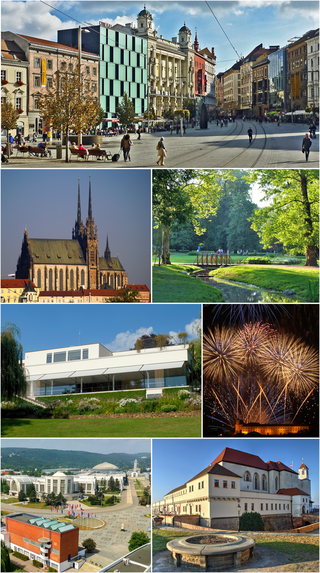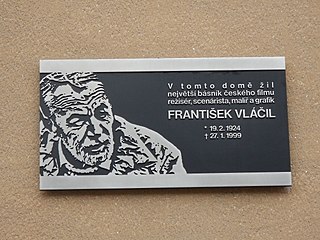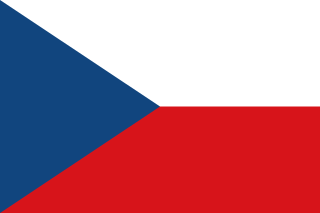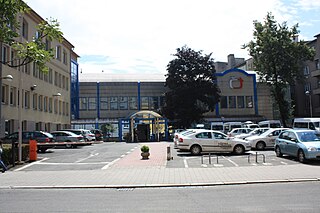
Brno is a city in the South Moravian Region of the Czech Republic. Located at the confluence of the Svitava and Svratka rivers, Brno has about 400,000 inhabitants, making it the second-largest city in the Czech Republic after the capital, Prague, and one of the 100 largest cities of the European Union. The Brno metropolitan area has approximately 720,000 inhabitants.

František Vláčil was a Czech film director, painter, and graphic artist.

Czech Television is a public television broadcaster in the Czech Republic, broadcasting six channels. Established after breakup of Czechoslovakia in 1992, it is the successor to Czechoslovak Television founded in 1953.

Český rozhlas (CRo) is the public radio broadcaster of the Czech Republic operating continuously since 1923. It is the oldest radio broadcaster in continental Europe and the second oldest in Europe after the BBC. Český Rozhlas was established in 1992 by the Czech Radio Act, which sets out the framework for its operation and financing. It acts as the successor to the previous state-owned Czechoslovak Radio which ceased to exist by 1992.

The Czech Republic, presented as Czechia since 2023, has participated in the Eurovision Song Contest 11 times since making its debut in 2007. After receiving nul points in the semi-final of the 2009 contest and due to a lack of interest from the Czech public, Czech broadcaster Česká televize (ČT) decided to withdraw from the contest; the country would not participate again until 2015.
Television was introduced in Czechoslovakia in 1953. Experimental projects with DVB-T started in 2000. Finally on 21 October 2005, multiplex A (DVB-T) was launched with three channels of Česká televize and one of TV Nova and radio channels of Český rozhlas.

ČT1 is the Czech public television channel, operated by Czech Television. ČT1 is a general purpose channel, showing family-oriented television, Czech movies, children's programming, news and documentaries.
ČT24 is a 24-hour news channel in Czech, owned and operated by Czech Television. The channel was launched on 2 May 2005.

The Film and TV School of the Academy of Performing Arts in Prague or FAMU is a film school in Prague, Czech Republic, founded in 1946 as one of three branches of the Academy of Performing Arts in Prague. It is the fifth oldest film school in the world. The teaching language on most courses at FAMU is Czech, but FAMU also runs certain courses in English. The school has repeatedly been included on lists of the best film schools in the world by The Hollywood Reporter.

The Czech TV crisis occurred at the end of 2000 and lasted until February 2001 as a battle for control of the airwaves, which included jamming and accusations of censorship. On 24 December 2000, news programs on Česká televize (ČT) were interrupted by Jana Bobošíková, a veteran presenter at the channel and the newly appointed head of the news department, sitting next to Jiří Hodač, a former BBC employee who had been appointed general manager of ČT on 20 December.

Petr Fiala is a Czech politician and political scientist who has been the prime minister of the Czech Republic since November 2021 and leader of the Civic Democratic Party (ODS) since 2014. He previously served as the Minister of Education, Youth and Sports from 2012 to 2013. Prior to entering politics, he was the rector of Masaryk University.
ČT art is a Czech national television channel, operated by Czech Television specialising in cultural content. The channel began broadcasting on 31 August 2013, with Tomáš Motl as its first executive director.

ČT Déčko is a Czech free-to-air television channel operated by Czech Television, specialising in children's content designed for young viewers 2 to 12 years of age. The channel began broadcasting on 31 August 2013, with Petr Koliha as its first executive director.

ČT3 was a Czech public television channel, operated by Czech Television. ČT3 broadcast originally in 1993 when it replaced the previous station OK3. Unlike the other two channels of the Czech Television at the time, ČT1 and ČT2, ČT3 broadcast its program largely in foreign languages and 24 hours a day.

Četníci z Luhačovic is a Czech crime television series. Its creative producer was Jan Maxa, the author of the project and main scriptwriter Petr Bok, Tomáš Feřtek also participated in the scripts. Directed by Biser A. Arichtev, Peter Bebjak and Dan Wlodarczyk. The plot of the series takes place in 1919. The central pair of young First Republic policemen were portrayed by Robert Hájek and Martin Donutil. The premiere of the first part took place on 6 January 2017.

Dobré ráno, Brno! is a comedy television series directed by Jan Prušinovský, who also co-wrote the screenplay with Tomáš Holeček. Prušinovský was inspired by Czech TV show Dobré ráno. The series he exaggerates and parodies Dobré ráno, its crew and the behind-the-scenes situations. Prušinovský wrote the script for the series based on his own experience when he himself was a guest on the Dobré ráno broadcast in the Brno studio. The series starrs Jan Kolařík, Zuzana Zlatohlávková, Ondřej Kokorský, Simona Lewandowská, Roman Slovák, Tereza Volánková, Ivana Hloužková and Nikola Mucha.

iVysílání is a streaming platform of Czech Television. It offers television programmes produced by Czech Television along with films and programmes that Television has its license. Programmes and films can be viewed for free. Viewers can also watch broadcast of Czech Television channels.

Television Studio Ostrava is a regional studio of Czech Television in Ostrava established by law. It was established in the fall of 1955 as the first non-Prague television studio of the then Czechoslovak Radio and began broadcasting on December 31 of the same year with a New Year's program. It is based in the center of Moravská Ostrava and had 249 employees at the end of 2020. The newsroom of the Ostrava Television Studio also includes the newsrooms in Olomouc and Krnov and their staff.
Archive and program funds of the Czech Television is a specialized archive of the Czech Television. Organizationally, it is divided into three separate departments in Prague, Brno and Ostrava.
Teletext ČT is a teletext service provided by Czech Television.


















